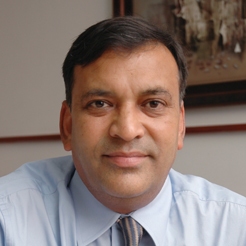Interview with Akhil Gupta, Deputy Group CEO and MD, Bharti Enterprises
January 25, 2011

After acquiring the African operations of Zain Telecom, Bharti Airtel spent the better part of the year putting processes in place and realigning tariffs in several markets to make services more affordable. Akhil Gupta, deputy group CEO and MD, Bharti Enterprises, talks about the hyper-competition in the market, 3G services and future trends. Excerpts…
What is the timeline for Bharti Airtel’s pan-Indian 3G launch?
We expect that over the next three months, Airtel’s 3G advantage will be available across all the 13 areas where we hold 3G licences. In addition, we will partner with quality operators to offer 3G services in other service areas, thereby providing 3G services, including seamless roaming, to our customers across India.
What are the key challenges faced by the company in 3G rollouts?
3G is new to India. Almost all the operators are rolling out their networks simultaneously. Therefore, the challenges faced by the operators will be somewhat similar. Though there will be obvious similarities in the supplier and partner ecosystems with 2G, some of the challenges will be unique to 3G.
How is 3G likely to change the market dynamics in the Indian case?
We see 3G as a great enabler in people’s lives. It will usher in a new era in connectivity, productivity and entertainment. In collaboration with developer partners, the industry will help bring exciting capabilities to the customers. With 3G, everything you thought you wanted to do on the phone will now be possible. Customers can watch movies, download content, network with people, make video calls, etc. One key change in market dynamics will take place in the mobile internet space. Today, internet penetration is hampered due to the low penetration of desktops and laptops. With the introduction of 3G, a complete transformation of the internet-enabled device ecosystem is expected. Mobile is going to be the primary instrument of the internet revolution in India.
What has been Bharti’s African experience so far? What has been the response to its services?
The response has been quite encouraging.
• We have realigned our tariffs in several markets to make our services affordable to customers and ensure our competitiveness. While we did that, we saw new acquisitions and the first signs of elasticity in usage, which was evident in the numbers reported for the September 2010 quarter.
• The recorded subscriber base went up by 3.7 million customers in a single quarter, up 50 per cent against the 2.3 million in the June quarter (June pro-rated for full quarter). The overall usage went up by 13 per cent over the preceding quarter, leading to a positive revenue improvement of 4 per cent over the June quarter.
• Governments and regulators across markets are also happy with Bharti’s initiatives for contributing to the objectives of increased teledensity and affordability.
Given the current hyper-market scenario in the telecom sector, how imperative is it to ease the consolidation norms in the sector?
It is now fairly clear that the current situation of 12-13 operators is not sustainable. We believe some consolidation is inevitable. We believe that the government is taking cognizance of this fact and that this aspect will be addressed in the proposed National Telecom Policy, 2011.
What is your vision for Bharti Airtel over the next two to three years?
We have prepared a new vision document to guide us in the coming years. Known as Vision 2015, it will help us have a deeper connect with our customers and serve them in the best possible manner. Enriching the lives of all our stakeholders – customers, employees and partners – forms the core of our Vision 2015. Airtel aspires to be the most loved brand, enriching the lives of millions across Asia and Africa. The company expects newer streams of data revenue in the coming years with the introduction of 3G and BWA services.
Does Bharti have any wish list that would enable the telecom sector to maintain the growth momentum?
As we move forward, we are going to come across many new life-enhancing services. Besides the operational challenges, operators will be facing different regulatory challenges concerning these services. We expect an enabling policy environment in the country that facilitates the growth of new services like m-health, m-banking and m-commerce. Regulators across sectors need to collaborate to ensure the smooth rollout of these new services. Our wish list is to have a level playing field for all operators and a stable regulatory environment, including but not limited to making available the required spectrum to operators who need more spectrum based on subscriber-linked criteria.
What is Airtel’s strategy to retain customers and maximise acquisitions in light of the launch of mobile number portability (MNP)? What is the number of Airtel port-outs observed in the Haryana pilot?
With India’s largest and deepest network, Airtel is confident that MNP will be overall in its favour. In Haryana, Airtel had a net gain as a result of MNP.
- Most Viewed
- Most Rated
- Most Shared
- Related Articles
- R.K. Upadhyay, Chairman and MD, BSNL
- Interview with Shashin Devsare, Executiv...
- Interview with Marten Pieters, MD and CE...
- Marten Pieters, Managing Director and Ch...
- B.S. Shantharaju, CEO, Indus Towers
- Views of Sandeep Nair, MD, Emerson Netwo...
- Interview with Samaresh Parida, Director...
- Interview with Himanshu Kapania, Deputy ...
- Interview with J.S. Sarma, Chairman, TRA...
- Views of Dhananjay Pavgi, Principal Cons...






